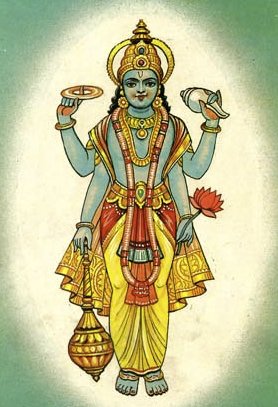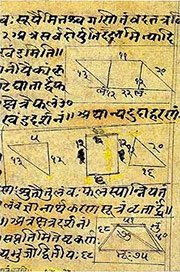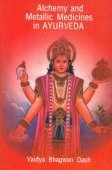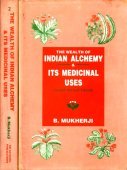Mahabhuta, Mahābhūta, Maha-bhuta: 25 definitions
Introduction:
Mahabhuta means something in Buddhism, Pali, Hinduism, Sanskrit, Jainism, Prakrit, the history of ancient India, Marathi. If you want to know the exact meaning, history, etymology or English translation of this term then check out the descriptions on this page. Add your comment or reference to a book if you want to contribute to this summary article.
In Hinduism
Ayurveda (science of life)
Source: PMC: The scientific basis of rasa (taste)Ayurveda uses Pañcamahābhūta theory as the fundamental basis of drug action. Each and every substance in this universe is considered to be made up of Pañcamahābhūta. Although, for easier understanding the term bhūta has been translated as basic elements, elementary particles, etc., but Vedic knowledge conceptualized the bhūta, not entirely on a material basis. Bhūtas are entities that can be perceived by the Jñānendriyas and thus have a holistic sense much beyond the material basis.
The bhūtas have practical applications in Ayurveda. A set of properties and actions is attributed to each of these mahābhūtas, one or some or all of which can be manifested in a substance when the mahābhūtas are present in a state of activation. Mere presence of mahābhūta will not lead to the manifestation of properties and actions, but the utkarṣa (activated/advantageous state) of mahābhūtas is fundamental to the expression of properties and actions.
Source: gurumukhi.ru: Ayurveda glossary of termsMahābhūta (महाभूत):—Great Elements; the five proto-elements AAkaasa, Vaayu, Teja, Jala and Prithvi which are the basic constituents of all substances

Āyurveda (आयुर्वेद, ayurveda) is a branch of Indian science dealing with medicine, herbalism, taxology, anatomy, surgery, alchemy and related topics. Traditional practice of Āyurveda in ancient India dates back to at least the first millenium BC. Literature is commonly written in Sanskrit using various poetic metres.
Vaishnavism (Vaishava dharma)
Source: ISKCON Press: GlossaryMahābhūta (महाभूत).—The five material elements: earth, water, fire, air and ether.

Vaishnava (वैष्णव, vaiṣṇava) or vaishnavism (vaiṣṇavism) represents a tradition of Hinduism worshipping Vishnu as the supreme Lord. Similar to the Shaktism and Shaivism traditions, Vaishnavism also developed as an individual movement, famous for its exposition of the dashavatara (‘ten avatars of Vishnu’).
Purana and Itihasa (epic history)
Source: Cologne Digital Sanskrit Dictionaries: The Purana IndexMahābhūta (महाभूत).—Five in number.*
- * Vāyu-purāṇa 101. 345.

The Purana (पुराण, purāṇas) refers to Sanskrit literature preserving ancient India’s vast cultural history, including historical legends, religious ceremonies, various arts and sciences. The eighteen mahapuranas total over 400,000 shlokas (metrical couplets) and date to at least several centuries BCE.
Ganitashastra (Mathematics and Algebra)
Source: archive.org: Hindu MathematicsMahābhūta (महाभूत) represents the number 5 (five) in the “word-numeral system” (bhūtasaṃkhyā), which was used in Sanskrit texts dealing with astronomy, mathematics, metrics, as well as in the dates of inscriptions and manuscripts in ancient Indian literature.—A system of expressing numbers by means of words arranged as in the place-value notation was developed and perfected in India in the early centuries of the Christian era. In this system the numerals [e.g., 5—mahābhūta] are expressed by names of things, beings or concepts, which, naturally or in accordance with the teaching of the Śāstras, connote numbers.

Ganitashastra (शिल्पशास्त्र, gaṇitaśāstra) refers to the ancient Indian science of mathematics, algebra, number theory, arithmetic, etc. Closely allied with astronomy, both were commonly taught and studied in universities, even since the 1st millennium BCE. Ganita-shastra also includes ritualistic math-books such as the Shulba-sutras.
General definition (in Hinduism)
Source: Veda (wikidot): HinduismThe Five Gross Elements of Matter (Maha-bhuta):
- akasha-tattva: ether
- vayu-tattva: air
- tejas-tattva: fire
- apas-tattva: water
- prithivi-tattva: earth
Ether, Air, Fire, Water and Earth are condensations of the above described Primary Sensations. They represent the constituent forces that in various combinations make up the material substance of which physical objects are made.
For example, that which gives solidity to an object, belongs to the Earth-Tattva. That which gives fluidity belongs to the Water-Tattva. That which gives form and shape belongs to Fire. That which gives movement belongs to Air. And that which gives location and extension in space (i.e., size, direction, etc.) belongs to Ether.
Due to variation in their materiality or subtlety, the Gross Tattvas are perceived variously. Earth is perceived by its qualities of odour, taste, colour, feel and sound; Water by its qualities of taste, colour, feel and sound; Fire by its qualities of colour, feel and sound; Air by its qualities of feel and sound; and Ether, being the most subtle, is perceived by its qualitiy of sound, only.
In Buddhism
Theravada (major branch of Buddhism)
Source: Pali Kanon: Manual of Buddhist Terms and Doctrinesthe 4 'primary elements', is another name for the 4 elements (dhātu) underlying all corporeality..
Theravāda is a major branch of Buddhism having the the Pali canon (tipitaka) as their canonical literature, which includes the vinaya-pitaka (monastic rules), the sutta-pitaka (Buddhist sermons) and the abhidhamma-pitaka (philosophy and psychology).
Mahayana (major branch of Buddhism)
Source: Wisdom Library: Maha Prajnaparamita SastraMahābhūta (महाभूत) refers to “four great elements”, according to the 2nd century Mahāprajñāpāramitāśāstra chapter XLIX.—The four great elements (mahābhūta) are the elements (dhātu):
- earth (pṛthivī),
- water (ap-),
- fire (tejas),
- wind (vāyu).
By cultivating the Prajñāpāramitā, this great earth (mahāpṛthivī) is reduced to its subtle atoms (paramāṇu). Because the earth element (pṛthivī) possesses color (rūpa), odor (gandha), taste (rasa) and touch (spraṣṭavya), it is heavy (guru) and does not have activity (kriyā) on its own. Because the water (ap-) element has no taste (rasa), it is superior to earth by means of its movement (calana). Because the fire (tejas) element has neither odor (gandha) nor taste (rasa), it is superior to water in its power (prabhāva). Because the wind (vāyu) element is neither visible (rūpa) nor has it any taste (rasa) or touch (spraṣṭavya), it is superior to fire by means of its movement (īraṇa). The mind (citta) which has none of these four things [color, taste, smell and touch] has a still greater power.

Mahayana (महायान, mahāyāna) is a major branch of Buddhism focusing on the path of a Bodhisattva (spiritual aspirants/ enlightened beings). Extant literature is vast and primarely composed in the Sanskrit language. There are many sūtras of which some of the earliest are the various Prajñāpāramitā sūtras.
Tibetan Buddhism (Vajrayana or tantric Buddhism)
Source: OSU Press: Cakrasamvara SamadhiMahābhūta (महाभूत) refers to the “great elements” (i.e., wind, fire, water, and earth), according to the Guru Mandala Worship (maṇḍalārcana) ritual often performed in combination with the Cakrasaṃvara Samādhi, which refers to the primary pūjā and sādhanā practice of Newah Mahāyāna-Vajrayāna Buddhists in Nepal.—Accordingly, “Oṃ in the middle of mantra inhabited ground, arisen of the four seeds, yaṃ, etc., a maṇḍala of the great elements (mahābhūta), wind, fire, water, and earth, Above that, (arising from) the letter suṃ, is the merumaṇḍala, Above that, on a jeweled lion-throne, lotus, and a lunar-disc, Śrī Vajrasattva, two arms, one face, white color, Holding a vajra (and) vajra-bell, (and) adorned wearing various colors, Bearing a monk’s headdress, (and) a sapphire Akṣobhya adorned crown, Thus imagine the worshipful guru[...]”.
Source: academia.edu: The Structure and Meanings of the Heruka MaṇḍalaMahābhūta (महाभूत) refers to the “(eight) great spirits (or beings)” or “(eight) direction-guardians”, according to the Sampuṭodbhava.—In connection with these eight trees and direction-guardians (aṣṭa-mahābhūta), the Sampuṭodbhava also mentions the eight charnel grounds (aṣṭaśmaśāna) and the cloud king (megharāja). However, it does not teach the respective names of the eight charnel grounds, and the cloud king is mentioned as a deity residing in the aśoka (= kaṅkeli) tree in the west (Skt. 3.4.65 and 67 ab). The cloud king in the west became the eight cloud kings residing in the eight directions in the Saṃvarodaya.

Tibetan Buddhism includes schools such as Nyingma, Kadampa, Kagyu and Gelug. Their primary canon of literature is divided in two broad categories: The Kangyur, which consists of Buddha’s words, and the Tengyur, which includes commentaries from various sources. Esotericism and tantra techniques (vajrayāna) are collected indepently.
General definition (in Buddhism)
Source: Wisdom Library: Dharma-samgrahaMahābhūta (महाभूत) or Pañcamahābhūta refers to the “five great elements” as defined in the Dharma-saṃgraha (section 39):
- pṛthvī (earth),
- āpas (water),
- tejas (fire),
- vāyu (wind),
- ākāśa (space).
The Dharma-samgraha (Dharmasangraha) is an extensive glossary of Buddhist technical terms in Sanskrit (e.g., mahābhūta). The work is attributed to Nagarjuna who lived around the 2nd century A.D.
Source: WikiPedia: BuddhismMahābhūta is Sanskrit and Pāli for "great element."
In Hinduism's sacred literature, the "great" or "gross" elements (mahābhūta) are fivefold:
- space (or "ether"),
- air,
- fire,
- water
- and earth.
In Buddhism, the four Great Elements (Pali: cattāro mahābhūtāni) are
- earth,
- water,
- fire
- and air.
Mahābhūta is generally synonymous with catudhātu, which is Pāli for the "Four Elements."
In Jainism
General definition (in Jainism)
Source: Wisdom Library: JainismMahābhūta (महाभूत) refers to a class of bhūta deities according to the Digambara tradition of Jainism, while Śvetāmbara does not recognize this class. The bhūtas refer to a category of vyantaras gods which represents one of the four classes of celestial beings (devas).
The deities such as the Mahābhūtas are defined in ancient Jain cosmological texts such as the Saṃgrahaṇīratna in the Śvetāmbara tradition or the Tiloyapaṇṇati by Yativṛṣabha (5th century) in the Digambara tradition.

Jainism is an Indian religion of Dharma whose doctrine revolves around harmlessness (ahimsa) towards every living being. The two major branches (Digambara and Svetambara) of Jainism stimulate self-control (or, shramana, ‘self-reliance’) and spiritual development through a path of peace for the soul to progess to the ultimate goal.
India history and geography
Source: Cologne Digital Sanskrit Dictionaries: Indian Epigraphical GlossaryMahābhūta.—(IE 7-1-2), ‘five’. Note: mahābhūta is defined in the “Indian epigraphical glossary” as it can be found on ancient inscriptions commonly written in Sanskrit, Prakrit or Dravidian languages.

The history of India traces the identification of countries, villages, towns and other regions of India, as well as mythology, zoology, royal dynasties, rulers, tribes, local festivities and traditions and regional languages. Ancient India enjoyed religious freedom and encourages the path of Dharma, a concept common to Buddhism, Hinduism, and Jainism.
Languages of India and abroad
Pali-English dictionary
Source: BuddhaSasana: Concise Pali-English Dictionarymahābhūta : (nt.) the four great elements.

Pali is the language of the Tipiṭaka, which is the sacred canon of Theravāda Buddhism and contains much of the Buddha’s speech. Closeley related to Sanskrit, both languages are used interchangeably between religions.
Marathi-English dictionary
Source: DDSA: The Molesworth Marathi and English Dictionarymahābhūta (महाभूत).—n (S) A primary element, as air, fire, water, earth, and ākāśa or ether.
Source: DDSA: The Aryabhusan school dictionary, Marathi-Englishmahābhūta (महाभूत).—n A primary element, as air, fire, &c.
Marathi is an Indo-European language having over 70 million native speakers people in (predominantly) Maharashtra India. Marathi, like many other Indo-Aryan languages, evolved from early forms of Prakrit, which itself is a subset of Sanskrit, one of the most ancient languages of the world.
Sanskrit dictionary
Source: DDSA: The practical Sanskrit-English dictionaryMahābhūta (महाभूत).—a great or primary element; see भूत (bhūta); तस्यैतस्य महाभूतस्य निःश्वसितमेतद्यदृग्वेदः (tasyaitasya mahābhūtasya niḥśvasitametadyadṛgvedaḥ) Up.; तं वेधा विदधे नूनं महाभूतसमाधिना (taṃ vedhā vidadhe nūnaṃ mahābhūtasamādhinā) R.1. 29; Manusmṛti 1.6. (-taḥ) 1 the Supreme Being.
2) a great creature.
Derivable forms: mahābhūtam (महाभूतम्).
Mahābhūta is a Sanskrit compound consisting of the terms mahā and bhūta (भूत).
Source: Cologne Digital Sanskrit Dictionaries: Shabda-Sagara Sanskrit-English DictionaryMahābhūta (महाभूत).—n.
(-taṃ) 1. A primary element; as air, fire, water, earth, and Akas or æther. 2. A great creature. E. mahā principal, bhūta element.
Source: Cologne Digital Sanskrit Dictionaries: Cappeller Sanskrit-English DictionaryMahābhūta (महाभूत).—[adjective] (being) great; [masculine] great creature or being; [neuter] grosser element (ph.).
Source: Cologne Digital Sanskrit Dictionaries: Monier-Williams Sanskrit-English Dictionary1) Mahābhūta (महाभूत):—[=mahā-bhūta] [from mahā > mah] mfn. being great, gr°, [Mahābhārata]
2) [v.s. ...] m. a gr° creature or being, [ib.]
3) [v.s. ...] n. a great element, gross el° (of which 5 are reckoned, viz. ether, air, fire, water, earth, [Upaniṣad; Nirukta, by Yāska; Manu-smṛti] etc. cf. [Indian Wisdom, by Sir M. Monier-Williams 83, 221], as distinguished from the subtle el° or Tanmātra, q.v.), [Indian Wisdom, by Sir M. Monier-Williams 221]
Source: Cologne Digital Sanskrit Dictionaries: Yates Sanskrit-English DictionaryMahābhūta (महाभूत):—[mahā-bhūta] (taṃ) 1. n. A primary element.
[Sanskrit to German]
Sanskrit, also spelled संस्कृतम् (saṃskṛtam), is an ancient language of India commonly seen as the grandmother of the Indo-European language family (even English!). Closely allied with Prakrit and Pali, Sanskrit is more exhaustive in both grammar and terms and has the most extensive collection of literature in the world, greatly surpassing its sister-languages Greek and Latin.
Kannada-English dictionary
Source: Alar: Kannada-English corpusMahābhūta (ಮಹಾಭೂತ):—[noun] any of the five basic elements believed to constitute all physical matter in the world.
Kannada is a Dravidian language (as opposed to the Indo-European language family) mainly spoken in the southwestern region of India.
See also (Relevant definitions)
Starts with: Mahabhutadana, Mahabhutaghata, Mahabhutaghata-dana, Mahabhutaka, Mahabhutamandala, Mahabhutanga, Mahabhutarava, Mahabhutasamatasadhana, Mahabhutatmabhuta, Mahabhutatman.
Ends with: Ashtamahabhuta, Pamcamahabhuta, Pancamahabhuta, Panchamahabhuta.
Full-text (+105): Tanmatra, Purusha, Apyadravya, Parthivadravya, Mahabhutadana, Rashipurusha, Catudhatu, Pancamahabhuta, Mahabhutaghata, Samanyaguna, Mardava, Saushirya, Pancikarana, Vicara, Vaisheshikaguna, Upacaya, Vishyanda, Akashiyadravya, Prakasha, Upakleda.
Relevant text
Search found 77 books and stories containing Mahabhuta, Mahābhūta, Maha-bhuta, Mahā-bhūta; (plurals include: Mahabhutas, Mahābhūtas, bhutas, bhūtas). You can also click to the full overview containing English textual excerpts. Below are direct links for the most relevant articles:
Patthana Dhamma (by Htoo Naing)
Chapter 12 - Nissaya paccayo (or dependence condition)
Chapter 27 - Avigata paccayo (or non-disappearance condition)
Samkhya thoughts in the Mahabharata (by Shini M.V.)
The five Mahābhūtas (physical elements) < [Chapter 2 - The Principles of Sāṃkhya Philosophy]
Branches of Sāṃkhya < [Chapter 2 - The Principles of Sāṃkhya Philosophy]
Resume < [Chapter 4 - Sāṃkhya thoughts in the Śānti-parva of Mahābhārata]
Philosophy of Charaka-samhita (by Asokan. G)
The theory of five physical substances (pañcabhūta-siddhānta) < [Chapter 3 - Fundamental Theories]
Cosmology [in Charaka philosophy] < [Chapter 3 - Fundamental Theories]
The locations, qualities, and the functions of the doṣas < [Chapter 3 - Fundamental Theories]
Sivaprakasam (Study in Bondage and Liberation) (by N. Veerappan)
Evolution of tattvas < [Chapter 2 - Bondage]
The Vipassana Dipani (by Mahathera Ledi Sayadaw)
A History of Indian Philosophy Volume 1 (by Surendranath Dasgupta)
Part 5 - The Khandhas < [Chapter V - Buddhist Philosophy]
Part 10 - The Schools of Theravada Buddhism < [Chapter V - Buddhist Philosophy]
Related products


